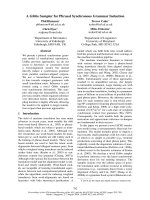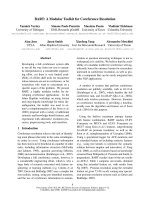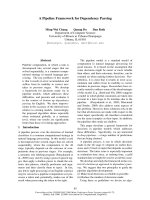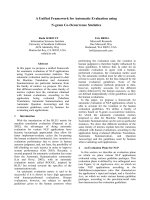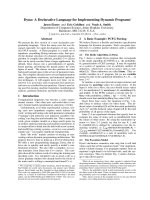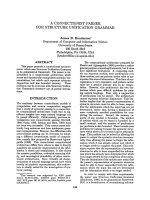Báo cáo khoa học: "A Connectionist Architecture for Learning to Parse" potx
Bạn đang xem bản rút gọn của tài liệu. Xem và tải ngay bản đầy đủ của tài liệu tại đây (731.55 KB, 7 trang )
A Connectionist Architecture for Learning to Parse
James Henderson and Peter Lane
Dept of Computer Science, Univ of Exeter
Exeter EX4 4PT, United Kingdom
j amie@dcs, ex. ac. uk, pclane~dcs, ex. ac. uk
Abstract
We present a connectionist architecture and demon-
strate that it can learn syntactic parsing from a cor-
pus of parsed text. The architecture can represent
syntactic constituents, and can learn generalizations
over syntactic constituents, thereby addressing the
sparse data problems of previous connectionist ar-
chitectures. We apply these Simple Synchrony Net-
works to mapping sequences of word tags to parse
trees. After training on parsed samples of the Brown
Corpus, the networks achieve precision and recall
on constituents that approaches that of statistical
methods for this task.
1 Introduction
Connectionist networks are popular for many of the
same reasons as statistical techniques. They are ro-
bust and have effective learning algorithms. They
also have the advantage of learning their own inter-
nal representations, so they are less constrained by
the way the system designer formulates the prob-
lem. These properties and their prevalence in cog-
nitive modeling has generated significant interest in
the application of connectionist networks to natu-
ral language processing. However the results have
been disappointing, being limited to artificial do-
mains and oversimplified subproblems (e.g. (Elman,
1991)). Many have argued that these kinds of con-
nectionist networks are simply not computationally
adequate for learning the complexities of real natural
language (e.g. (Fodor and Pylyshyn, 1988), (Hender-
son, 1996)).
Work on extending connectionist architectures for
application to complex domains such as natural lan-
guage syntax has developed a theoretically moti-
vated technique called Temporal Synchrony Variable
Binding (Shastri and Ajjanagadde, 1993; Henderson,
1996). TSVB allows syntactic constituency to be
represented, but to date there has been no empirical
demonstration of how a learning algorithm can be
effectively applied to such a network. In this paper
we propose an architecture for TSVB networks and
empirically demonstrate its ability to learn syntac-
tic parsing, producing results approaching current
statistical techniques.
In the next section of this paper we present the
proposed connectionist architecture, Simple Syn-
chrony Networks (SSNs). SSNs are a natural ex-
tension of Simple Kecurrent Networks (SRNs) (El-
man, I99I), which are in turn a natural extension
of Multi-Layered Perceptrons (MLPs) (Rumelhart
et al., 1986). SRNs are an improvement over MLPs
because they generalize what they have learned over
words in different sentence positions. SSNs are an
improvement over SKNs because the use of TSVB
gives them the additional ability to generalize over
constituents in different structural positions. The
combination of these generalization abilities is what
makes SSNs adequate for syntactic parsing.
Section 3 presents experiments demonstrating
SSNs' ability to learn syntactic parsing. The task
is to map a sentence's sequence of part of speech
tags to either an unlabeled or labeled parse tree,
as given in a preparsed sample of the Brown Cor-
pus. A network input-output format is developed
for this task, along with some linguistic assump-
tions that were used to simplify these initial ex-
periments. Although only a small training set was
used, an SSN achieved 63% precision and 69% re-
call on unlabeled constituents for previously unseen
sentences. This is approaching the 75% precision
and recall achieved on a similar task by Probabilis-
tic Context Free Parsers (Charniak, forthcoming),
which is the best current method for parsing based
on part of speech tags alone. Given that these are
the very first results produced with this method, fu-
ture developments are likely to improve on them,
making the future for this method very promising.
2 A Connectionist Architecture that
Generalizes over Constituents
Simple Synehrony Networks (SSNs) are designed to
extend the learning abilities of standard eonnec-
tionist networks so that they can learn generaliza-
tions over linguistic constituents. This generaliza-
tion ability is provided by using Temporal Synchrony
Variable Binding (TSVB) (Shastri and Ajjanagadde,
1993) to represent constituents. With TSVB, gener-
531
Hidden
Input
~ut
II |1
I I I
; ; ;
copy
,' ,' ,' ,' links
#1 is eS
SS
: [ ,'/;
, I ss~sr t
: :_._- : gg-: -
Figure 1: A Simple Recurrent Network.
alization over constituents is achieved in an exactly
analogous way to the way Simple Recurrent Net-
works (SRNs) (Elman, 1991) achieve generalization
over the positions of words in a sentence. SRNs are
a standard connectionist method for processing se-
quences. As the name implies, SSNs are one way of
extending SRNs with TSVB.
2.1 Simple Recurrent Networks
Simple Recurrent Networks (Elman, 1991) are a sim-
ple extension of the most popular form of connec-
tionist network, Multi-Layered Perceptrons (MLPs)
(Rumelhart et al., 1986). MLPs are popular because
they can approximate any finite mapping, and be-
cause training them with the Backpropagation learn-
ing algorithm (Rumelhart et al., 1986) has been
demonstrated to be effective in a wide variety of
applications. Like MLPs, SRNs consist of a finite
set of units which are connected by weighted links,
as illustrated in figure 1. The output of a unit is
simply a scalar activation value. Information is in-
put to a network by placing activation values on the
input units, and information is read out of a net-
work by reading off activation values from the out-
put units. Computation is performed by the input
activation being scaled by the weighted links and
passed through the activation functions of the "hid-
den" units, which are neither part of the input nor
output. The only parameters in this computation
are the weights of the links and how many hidden
units are used. The number of hidden units is cho-
sen by the system designer, but the link weights are
automatically trained using a set of example input-
output mappings and the Backpropagation learning
algorithm.
Unlike MLPs, SRNs process sequences of inputs
and produce sequences of outputs. To store infor-
mation about previous inputs, SRNs use a set of
context units, which simply record the activations
of the hidden units during the previous time step
(shown as dashed links in figure 1). When the SRN
is done computing the output for one input in the se-
quence, the vector of activations on the hidden units
is copied to the context units. Then the next input
is processed with this copied pattern in the context
units. Thus the hidden pattern computed for one
input is used to represent the context for the subse-
quent input. Because the hidden pattern is learned,
this method allows SRNs to learn their own inter-
nal representation of this context. This context is
the state of the network. A number of algorithms
exist for training such networks with loops in their
flow of activation (called recurrence), for example
Backpropagation Through Time (Rumelhart et al.,
1986).
The most important characteristic of any learning-
based model is the way it generalizes from the ex-
amples it is trained on to novel testing examples. In
this regard there is a crucial difference between SRNs
and MLPs, namely that SRNs generalize across se-
quence positions. At each position in a sequence a
new context is copied, a new input is read, and a
new output is computed. However the link weights
that perform this computation are the same for all
the positions in the sequence. Therefore the infor-
mation that was learned for an input and context in
one sequence position will inherently be generalized
to inputs and contexts in other sequence positions.
This generalization ability is manifested in the fact
that SRNs can process arbitrarily long sequences;
even the inputs at the end, which are in sequence
positions that the network has never encountered
before, can be processed appropriately. This gener-
alization ability is a direct result of SRNs using time
to represent sequence position.
Generalizing across sequence positions is crucial
for syntactic parsing, since a word tends to have the
same syntactic role regardless of its absolute position
in a sentence, and there is no practical bound on the
length of sentences. However this ability still doesn't
make SRNs adequate for syntactic parsing. Because
SRNs have a bounded number of output units, and
therefore an effectively bounded output for each in-
put, the space of possible outputs should be linear
in the length of the input. For syntactic parsing, the
total number of constituents is generally considered
to be linear in the length of the input, but each con-
stituent has to choose its parent from amongst all
the other constituents. This gives us a space of pos-
sible parent-child relationships that is proportional
to the square of the length of the input. For exam-
ple, the attachment of a prepositional phrase needs
to be chosen from all the constituents on the right
frontier of the current parse tree. There may be an
arbitrary number of these constituents, but an SRN
would have to distinguish between them using only
a bounded number of output units. While in the-
ory such a representation can be achieved using ar-
bitrary precision continuous activation values, this
532
bounded nature is symptomatic of a limitation in
SRNs' generalization abilities. What we really want
is for the network to learn what kinds of constituents
such prepositional phrases like to attach to, and ap-
ply these generalizations independently of the abso-
lute position of the constituent in the parse tree. In
other words, we want the network to generalize over
constituents. There is no apparent way for SRNs to
achieve such generalization. This inability to gener-
alize results in the network having to be trained on
a set of sentences in which every kind of constituent
appears in every position in the parse tree, result-
ing in serious sparse data problems. We believe that
it is this difficulty that has prevented the successful
application of SRNs to syntactic parsing.
2.2 Simple Synchrony Networks
The basic technique which we use to solve SRNs'
inability to generalize over constituents is exactly
analogous to the technique SRNs use to generalize
over sentence positions; we process constituents one
at a time. Words are still input to the network one
at a time, but now within each input step the net-
work cycles through the set of constituents. This
dual use of time does not introduce any new compli-
cations for learning algorithms, so, as for SRNs, we
can use Backpropagation Through Time. The use
of timing to represent constituents (or more gener-
ally entities) is the core idea of Temporal Synchrony
Variable Binding (Shastri and Ajjanagadde, 1993).
Simple Synchrony Networks are an application of
this idea to SRNs. 1
As illustrated in figure 2, SSNs use the same
method of representing state as do SRNs, namely
context units. The difference is that SSNs have
two of these memories, while SRNs have one. One
memory is exactly the same as for SRNs (the fig-
ure's lower recurrent component). This memory
has no representation of constituency, so we call
it the "gestalt" memory. The other memory has
had TSVB applied to it (the figure's upper recur-
rent component, depicted with "stacked" units).
This memory only represents information about con-
stituents, so we call it the constituent memory.
These two representations are then combined via an-
other set of hidden units to compute the network's
output. Because the output is about constituents,
these combination and output units have also had
TSVB applied to them.
The application of TSVB to the output units al-
lows SSNs to solve the problems that SR.Ns have
with representing the output of a syntactic parser.
For every step in the input sequence, TSVB units
cycle through the set of constituents. To output
1 There are a variety of ways to extend SRNs using TSVB.
The architecture presented here was selected based on previ-
ous experiments using a toy grammar.
Col
Con
Con
Ge.¢
Cor
Figure 2: A Simple Synchrony Network. The units
to which TSVB has been applied are depicted as
several units stacked on top of each other, because
they store activations for several constituents.
something about a particular constituent, it is sim-
ply necessary to activate an output unit at that
constituent's time in the cycle. For example, when
a prepositional phrase is being processed, the con-
stituent which that prepositional phrase attaches to
can be specified by activating a "parent" output unit
in synchrony with the chosen constituent. However
many constituents there are for the prepositional
phrase to choose between, there will be that many
times in the cycle that the "parent" unit can be acti-
vated in. Thereby we can output information about
an arbitrary number of constituents using only a
bounded number of units. We simply require an
arbitrary amount of time to go through all the con-
stituents.
Just as SRNs' ability to input arbitrarily long sen-
tences was symptomatic of their ability to generalize
over sentence position, the ability of SSNs to output
information about arbitrarily many constituents is
symptomatic of their ability to generalize over con-
stituents. Having more constituents than the net-
work has seen before is not a problem because out-
puts for the extra constituents are produced on the
same units by the same link weights as for other
constituents. The training that occurred for the
other constituents modified the link weights so as
to produce the constituents' outputs appropriately,
and now these same link weights are applied to the
533
extra constituents. So the SSN has generalized what
it has learned over constituents. For example, once
the network has learned what kinds of constituents a
preposition likes to attach to, it can apply these gen-
eralizations to each of the constituents in the current
parse and choose the best match.
In addition to their ability to generalize over con-
stituents, SSNs inherit from SRNs the ability to gen-
eralize over sentence positions. By generalizing in
both these ways, the amount of data that is nec-
essary to learn linguistic generalizations is greatly
reduced, thus addressing the sparse data problems
which we believe are the reasons connectionist net-
works have not been successfully applied to syntactic
parsing. The next section empirically demonstrates
that SSNs can be successfully applied to learning the
syntactic parsing of real natural language.
3 Experiments in Learning to Parse
Adding the theoretical ability to generalize over lin-
guistic constituents is an important step in connec-
tionist natural language processing, but theoretical
arguments are not sufficient to address the empir-
ical question of whether these mechanisms are ef-
fective in learning to parse real natural language.
In this section we present experiments on training
Simple Synchrony Networks to parse naturally oc-
curring sentences. First we present the input-output
format for the SSNs used in these experiments, then
we present the corpus, then we present the results,
and finally we discuss likely future developments.
Despite the fact that these are the first such ex-
periments to be designed and run, an SSN achieved
63% precision and 69% recall on constituents. Be-
cause these results are approaching the results for
current statistical methods for parsing from part of
speech tags (around 75% precision and recall), we
conclude that SSNs are effective in learning to parse.
We anticipate that future developments using larger
training sets, words as inputs, and a less constrained
input-output format will make SSNs a real alterna-
tive to statistical methods.
3.1 SSNs for Parsing
The networks that are used in the experiments all
have the same design. They all use the internal
structure discussed in section 2.2 and illustrated in
figure 2, and they all use the same input-output for-
mat. The input-output format is greatly simplified
by SSNs' ability to represent constituents, but for
these initial experiments some simplifying assump-
tions are still necessary. In particular, we want to
define a single fixed input-output mapping for ev-
ery sentence. This gives the network a stable pat-
tern to learn, rather than having the network itself
make choices such as when information should be
output or which output constituent should be asso-
ciated with which words. To achieve this we make
two assumptions, namely that outputs should occur
as soon as theoretically possible, and that the head
of each constituent is its first terminal child.
As shown in figure 2, SSNs have two sets of in-
put units, constituent input units and gestalt input
units. Defining a fixed input pattern for the gestalt
inputs is straightforward, since these inputs per-
tain to information about the sentence as a whole.
Whenever a tag is input to the network, the activa-
tion pattern for that tag is presented to the gestalt
input units. The information from these tags is
stored in the gestalt context units, forming a holistic
representation of the preceding portion of the sen-
tence. The use of this holistic representation is a sig-
nificant distinction between SSNs and current sym-
bolic statistical methods, giving SSNs some of the
advantages of finite state methods. Figure 3 shows
an example parse, and depicts the gestalt inputs as
a tag just above its associated word. First NP is in-
put to the gestalt component, then VVZ, then AT,
and finally NN.
Defining a fixed input pattern for the constituent
input units is more difficult, since the input must be
independent of which tags are grouped together into
constituents. For this we make use of the assumption
that the first terminal child of every constituent is its
head. When a tag is input we add a new constituent
to the set of constituents that the network cycles
through and assume that the input tag is the head
of that constituent. The activation pattern for the
tag is input in synchrony with this new constituent,
but nothing is input to any of the old constituents.
In the parse depicted in figure 3, these constituent
inputs are shown as predications on new variables.
First constituent w is introduced and given the input
NP, then z is introduced and given VVZ, then y is
introduced and given AT, and finally z is introduced
and given NN.
Because the only input to a constituent is its head
tag, the only thing that the constituent context units
do is remember information about each constituent's
first terminal child. This is not a very realistic as-
sumption about the nature of the linguistic gener-
alizations that the network needs to learn, but it
is adequate for these initial experiments. This as-
sumption simply means that more burden is placed
on the network's gestalt memory, which can store in-
formation about any tag. Provided the appropriate
constituent can be identified based on its first termi-
nal child, this gestalt information can be transferred
to the constituent through the combination units at
the time when an output needs to be produced.
We also want to define a single fixed output pat-
tern for each sentence. This is necessary since we use
simple Backpropagation Through Time, plus it gives
the network a stable mapping to learn. This desired
output pattern is called the target pattern. The net-
534
Input Output Accumulated
Output
NP(w) w w
NP I I
(John) NP NP
X
vvz(X)wz w ~]
(loves) VVZ NP VVZ
X X
AT(y) ~y ~~
AT I
(a) AT
NP VVZ
AT
X
(woman) NN NP VVZ AT NN
Figure 3: A parse of "John loves a woman".
work is trained to try to produce this exact pattern,
even though other patterns may be interpretable as
the correct parse. To define a unique target output
we need to specify which constituents in the corpus
map to which constituents in the network, and at
what point in the sentence each piece of informa-
tion in the corpus needs to be output. The first
problem is solved by the assumption that the first
terminal child of a constituent is its head. 2 We map
each constituent in the corpus to the constituent in
the network that has the same head. Network con-
stituents whose head is not the first terminal child of
any corpus constituent are simply never mentioned
in the output, as is true of z in figure 3. The second
problem is solved by assuming that outputs should
occur as soon as theoretically possible. As soon as
all the constituents involved in a piece of information
have been introduced into the network, that piece
of information is required to be output. Although
this means that there is no point at which the entire
parse for a sentence is being output by the network,
we can simply accumulate the network's incremen-
tal outputs and thereby interpret the output of the
parser as a complete parse.
To specify an unlabeled parse tree it is sufficient
to output the tree's set of parent-child relationships.
For parent-child relationships that are between a
constituent and a terminal, we know the constituent
will have been introduced by the time the termi-
nal's tag is input because a constituent is headed
by its first terminal child. Thus this parent-child
relationship should be output when the terminal's
2The cases where constituents in the corpus
have no
ter-
minal children axe discussed in the next subsection.
tag is input. This is done using a "parent" output
unit, which is active in synchrony with the parent
constituent when the terminal's tag is input. In fig-
ure 3, these parent outputs are shown structurally as
parent-child relationships with the input tags. The
first three tags all designate the constituents intro-
duced with them as their parents, but the fourth tag
(NN) designates the constituent introduced with the
previous tag (y) as its parent.
For parent-child relationships that are between
two nonterminal constituents, the earliest this in-
formation can be output is when the head of the
second constituent is input. This is done using a
"grandparent" output unit and a "sibling" output
unit. The grandparent output unit is used when
the child comes after the parent's head (i.e. right
branching constituents like objects). In this case
the grandparent output unit is active in synchrony
with the parent constituent when the head of the
child constituent is input. This is illustrated in the
third row in figure 3, where AT is shown as having
the grandparent z. The sibling output unit is used
when the child precedes the parent's head (i.e. left
branching constituents like subjects). In this case
the sibling output unit is active in synchrony with
the child constituent when the head of the parent
constituent is input. This is illustrated in the sec-
ond row in figure 3, where VVZ is shown as having
the sibling w. These parent, grandparent, and sib-
ling output units are sumcient to specify any of the
parse trees that we require.
While training the networks requires having a
unique target output, in testing we can allow any
output pattern that is interpretable as the correct
parse. Interpreting the output of the network has
two stages. First, the continuous unit activations
are mapped to discrete parent-child relationships.
For this we simply take the maximums across com-
peting parent outputs (for terminal's parents), and
across competing grandparent and sibling outputs
(for nonterminal's parents). Second, these parent-
child relationships are mapped to their equivalent
parse "tree". This process is illustrated in the right-
most column of figure 3, where the network's incre-
mental output of parent-child relationships is accu-
mulated to form a specification of the complete tree.
This second stage may have some unexpected re-
sults (the constituents may be discontiguous, and
the structure may not be connected), but it will
always specify which words in the sentence each
constituent includes. By defining each constituent
purely in terms of what words it includes, we can
compare the constituents identified in the network's
output to the constituents in the corpus. As is stan-
dard, we report the percentage of the output con-
stituents that are correct (precision), and percentage
of the correct constituents that are output (recall).
535
3.2 A Corpus for SaNs
The Susanne 3 corpus is used in this paper as a source
of preparsed sentences. The Susanne corpus consists
of a subset of the Brown corpus, preparsed accord-
ing to the Susanne classification scheme described
in (Sampson, 1995). This data must be converted
into a format suitable for the learning experiments
described below. This section describes the conver-
sion of the Susanne corpus sentences and the preci-
sion/recall evaluation functions.
We begin by describing the part of speech tags,
which form the input to the network. The tags
in the Susanne scheme are a detailed extension of
the tags used in the Lancaster-Leeds Treebank (see
Garside et
al,
1987). For the experiments described
below the simpler Lancaster-Leeds scheme is used.
Each tag is a two or three letter sequence, e.g. 'John'
would be encoded 'NP', the articles 'a' and 'the' are
encoded 'AT', and verbs such as 'is' encoded 'VBZ'.
These are input to the network by setting one bit in
each of three banks of inputs; each bank representing
one letter position, and the set bit indicating which
letter or space occupies that position.
The network's output is an incremental represen-
tation of the unlabeled parse tree for the current
sentence. The Susanne scheme uses a detailed clas-
sification of constituents, and some changes are nec-
essary before the data can be used here. Firstly, the
experiments in this paper are only concerned with
parsing sentences, and so all constituents referring
to the meta-sentence level have been discarded. Sec-
ondly, the Susanne scheme allows for 'ghost' mark-
ers. These elements are also discarded, as the 'ghost'
elements do not affect the boundaries of the con-
stituents present in the sentence.
Finally, it was noted in the previous subsection
that the SSNs used for these learning experiments
require every constituent to have at least one termi-
nal child. There are very few constructions in the
corpus that violate this constraint, but one of them
is very common, namely the S-VP division. The lin-
guistic head of the S (the verb) is within the VP,
and thus the S often occurs without any tags as im-
mediate children. For example, this occurs when S
expands to simply NP VP. To address this problem,
we collapse the S and VP into a single constituent,
as is illustrtated in figure 3. The same is done for
other such constructions, which include adjective,
noun, determiner and prepositional phrases. This
move is not linguistically unmotivated, since the re-
sult is equivalent to a form of dependency grammar
(Mel~uk, 1988), which have a long linguistic tradi-
tion. The constructions are also well defined enough
3 We acknowledge the roles of the Economic and Social Re-
search Council (UK) as sponsor and the University of Sussex
as grantholder in providing the Susanne corpus used in the
experiments described in this paper.
Expt Training Cross val Test
Prec Rec Prec P~c Prec Rec
/~ / 75.6 79.1 66.7 71.9 60.4 66.5
71.675.868.273.862.669.4
(3) 64.271.458.666.959.868.5
Table 1: Results of experiments on Susanne corpus.
that the collapsed constituents could be separated
at the interpretation stage, but we don't do that in
these experiments. Also note that this limitation is
introduced by a simplifying assumption, and is not
inherent to the architecture.
3.3 Experimental Results
The experiments in this paper use one of the Susanne
genres (genre A, press reportage) for the selection
of training, cross-validation and test data. We de-
scribe three sets of experiments, training SSNs with
the input-output format described in section 3.1. In
each experiment, a variety of networks was trained,
varying the number of units in the hidden and com-
bination layers. Each network is trained using an
extension of Backpropagation Through Time until
the sum-squared error reaches a minimum. A cross-
validation data set is used to choose the best net-
works, which are then given the test data, and pre-
cision/recall figures obtained.
For experiments (1) and (2), the first twelve files in
Susanne genre A were used as a source for the train-
ing data, the next two for the cross-validation set
(4700 words in 219 sentences, average length 21.56),
and the final two for testing (4602 words in 176 sen-
tences, average length 26.15).
For experiment (1), only sentences of length less
than twenty words were used for training, resulting
in a training set of 4683 words in 334 sentences. The
precision and recall results for the best network can
be seen in the first row of table 1. For experiment
(2), a larger training set was used, containing sen-
tences of length less than thirty words, resulting in
a training set of 13,523 words in 696 sentences. We
averaged the performance of the best two networks
to obtain the figures in the second row of table 1.
For experiment (3),
labeled
parse trees were used
as a target output, i.e. for each word we also output
the label of its parent constituent. The output for
the constituent labels uses one output unit for each
of the 15 possible labels. For calculating the preci-
sion and recall results, the network must also output
the correct label with the head of a constituent in
order to count that constituent as correct. Further,
this experiment uses data sets selected at random
from the total set, rather than taking blocks from
the corpus. Therefore, the cross-validation set in
this case consists of 4551 words in 186 sentences,
average length 24.47 words. The test set consists of
536
4485 words in 181 sentences, average length 24.78
words. As in experiment (2), we used a training set
of sentences with less than 30 words, producing a set
of 1079 sentences, 27,559 words. For this experiment
none of the networks we tried converged to nontriv-
ial solutions on the training set, but one network
achieved reasonable performance before it collapsed
to a trivial solution. The results for this network are
shown in the third row of table 1.
From current corpus based statistical work on
parsing, we know that sequences of part of speech
tags contain enough information to achieve around
75% precision and recall on constituents (Charniak,
forthcoming). On the other extreme, the simplistic
parsing strategy of producing a purely right branch-
ing structure only achieves 34% precision and 61%
recall on our test set. The fact that SSNs can achieve
63% precision and 69% recall using much smaller
training sets than (Charniak, forthcoming) demon-
strates that SSNs can be effective at learning the
required generalizations from the data. While there
is still room for improvement, we conclude that SSNs
can learn to parse real natural language.
3.4 Extendabillty
The initial results reported above are very promis-
ing for future developments with Simple Synchrony
Networks, as they are likely to improve in both the
near and long term. Significant improvements are
likely with larger training sets and longer training
sentences. While other approaches typically use over
a million words of training data, the largest training
set we use is only 13,500 words. Also, fine tuning of
the training methodology and architecture often im-
proves network performance. For example we should
be using larger networks, since our best results came
from the largest networks we tried. Currently the
biggest obstacle to exploring these alternatives is the
long training times that are typical of Backpropa-
gation Through Time, but there are a number of
standard speedups which we will be trying.
Another source of possible improvements is to
make the networks' input-output format more lin-
guistically motivated. As an example, we retested
the networks from experiment 2 above with a dif-
ferent mapping from the output of the network to
constituents. If a word chooses an earlier word's
constituent as its parent, then we treat these two
words as being in the same constituent, even if the
earlier word has itself chosen an even earlier word
as its parent. 10% of the constituents are changed
by this reinterpretation, with precision improving by
1.6% and recall worsening by 0.6%.
In the longer term the biggest improvement is
likely to come from using words, instead of tags,
as the input to the network. Currently all the best
parsing systems use words, and back off to using tags
for infrequent words (Charniak, forthcoming). Be-
cause connectionist networks automatically exhibit
a
frequency by regularity effect where infrequent cases
are all pulled into the typical pattern, we would ex-
pect such backing off to be done automatically, and
thus we would expect SSNs to perform well with
words as inputs. The performance we have achieved
with such small training sets supports this belief.
4 Conclusion
This paper demonstrates for the first time that a
connectionist network can learn syntactic parsing.
This improvement is the result of extending a stan-
dard architecture (Simple Recurrent Networks) with
a technique for representing linguistic constituents
(Temporal Synchrony Variable Binding). This ex-
tension allows Simple Synchrony Networks to gen-
eralize what they learn across constituents, thereby
solving the sparse data problems of previous connec-
tionist architectures. Initial experiments have em-
pirically demonstrated this ability, and future ex-
tensions are likely to significantly improve on these
results. We believe that the combination of this gen-
eralization ability with the adaptability of connec-
tionist networks holds great promise for many areas
of Computational Linguistics.
References
Eugene Charniak. forthcoming. Statistical tech-
niques for natural language parsing. AI Magazine.
Jeffrey L. Elman. 1991. Distributed representa-
tions, simple recurrent networks, and grammatical
structure. Machine Learning, 7:195-225.
Jerry A. Fodor and Zenon W. Pylyshyn. 1988. Con-
nectionism and cognitive architecture: A critical
analysis. Cognition, 28:3-71.
R. Garside, G. Leech, and G. Sampson (eds). 1987.
The Computational Analysis of English: a corpus-
based approach. Longman Group UK Limited.
James Henderson. 1996. A connectionist architec-
ture with inherent systematicity. In Proceedings
of the Eighteenth Conference of the Cognitive Sci-
ence Society, pages 574-579, La Jolla, CA.
I. Mel~uk. 1988. Dependency Syntax: Theory and
Practice. SUNY Press.
D. E. Rumelhart, G. E. Hinton, and R. J. Williams.
1986. Learning internal representations by error
propagation. In D. E. Rumelhart and J. L. Mc-
Clelland, editors, Parallel Distributed Processing,
Vol 1. MIT Press, Cambridge, MA.
Geoffrey Sampson. 1995. English for the Computer.
Oxford University Press, Oxford, UK.
Lokendra Shastri and Venkat Ajjanagadde. 1993.
From simple associations to systematic reasoning:
A connectionist representation of rules, variables,
and dynamic bindings using temporal synchrony.
Behavioral and Brain Sciences, 16:417-451.
537


